Bài giảng Macroeconomics - Chapter 4: Short-run economic fluctuation (Part 2) - Nguyễn Thùy Dung
Monetary and Fiscal Policy
Monetary and Fiscal policy are used to offset shifts
in AD which cause short-run fluctuations in output
and employment.
▪ Monetary policy: the setting of the money supply
by policymakers in the central bank
▪ Fiscal policy: changes in government spending or
tax rates.Institute of International Education
How Monetary Policy Influences AD
▪ Recall, the AD curve slopes downward for three
reasons:
▪ The wealth effect
▪ The interest-rate effect
▪ The exchange-rate effect
▪ A supply-demand model that helps explain the
interest-rate effect and how monetary policy
affects AD
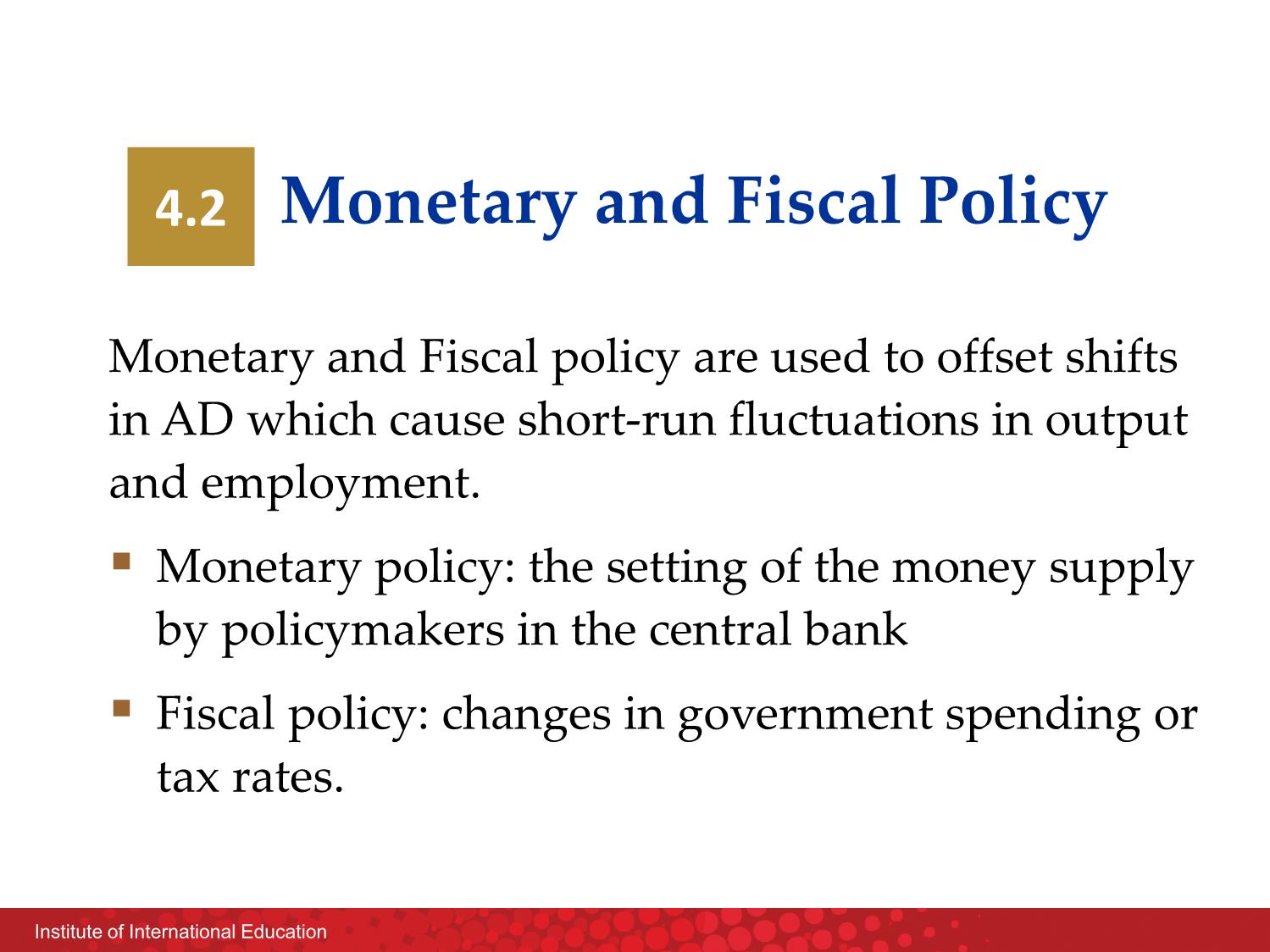
Trang 1

Trang 2
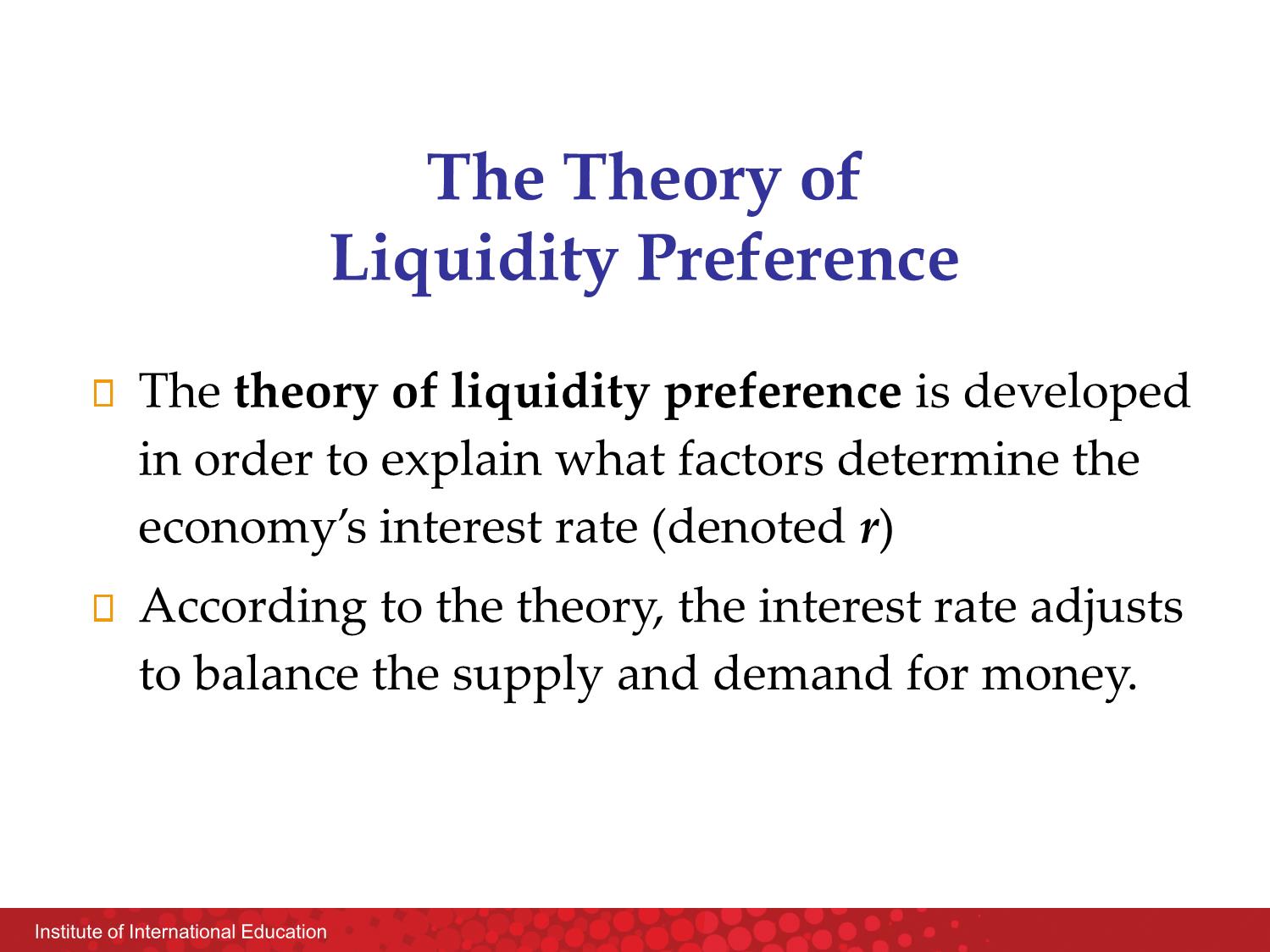
Trang 3
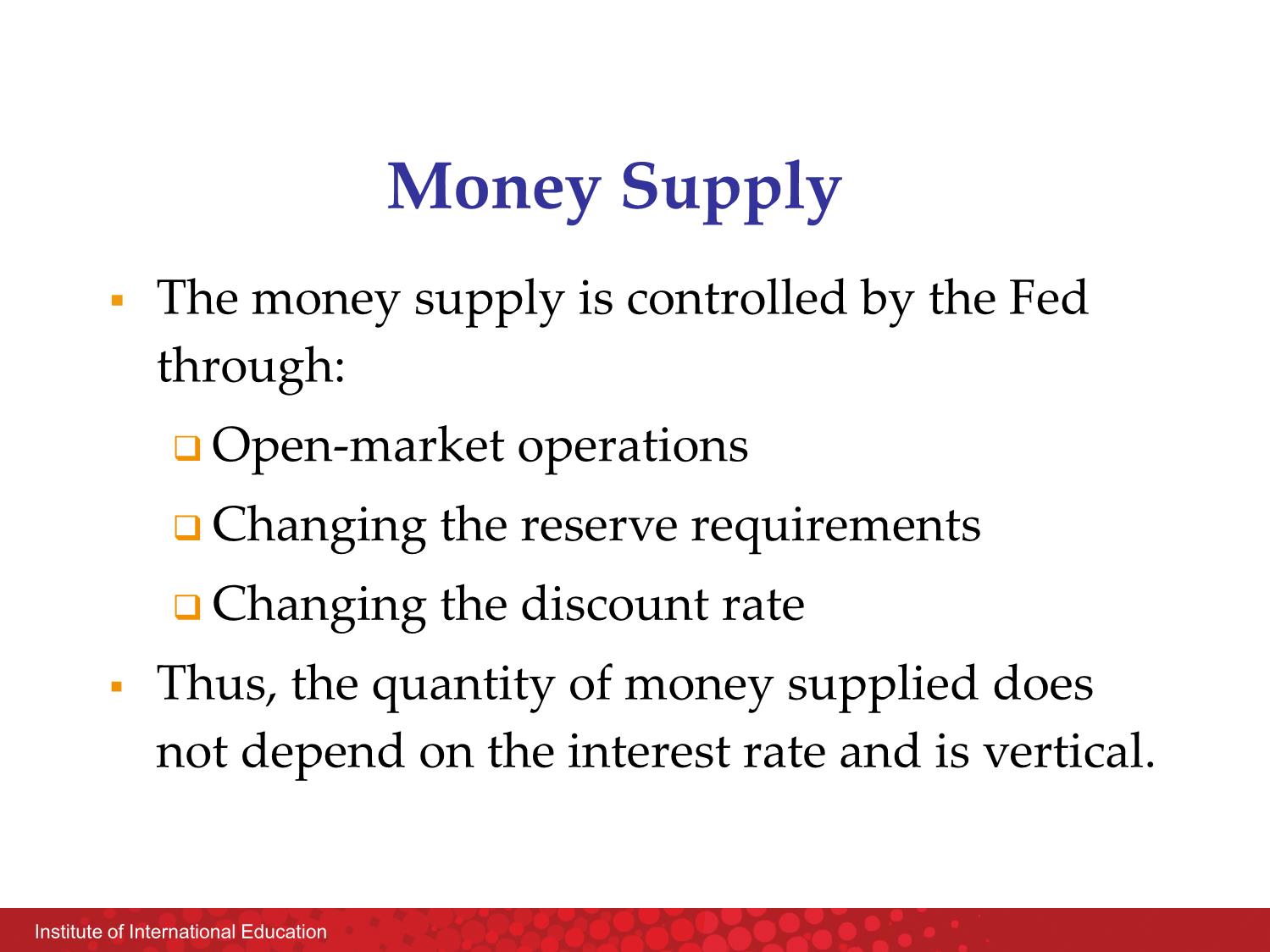
Trang 4
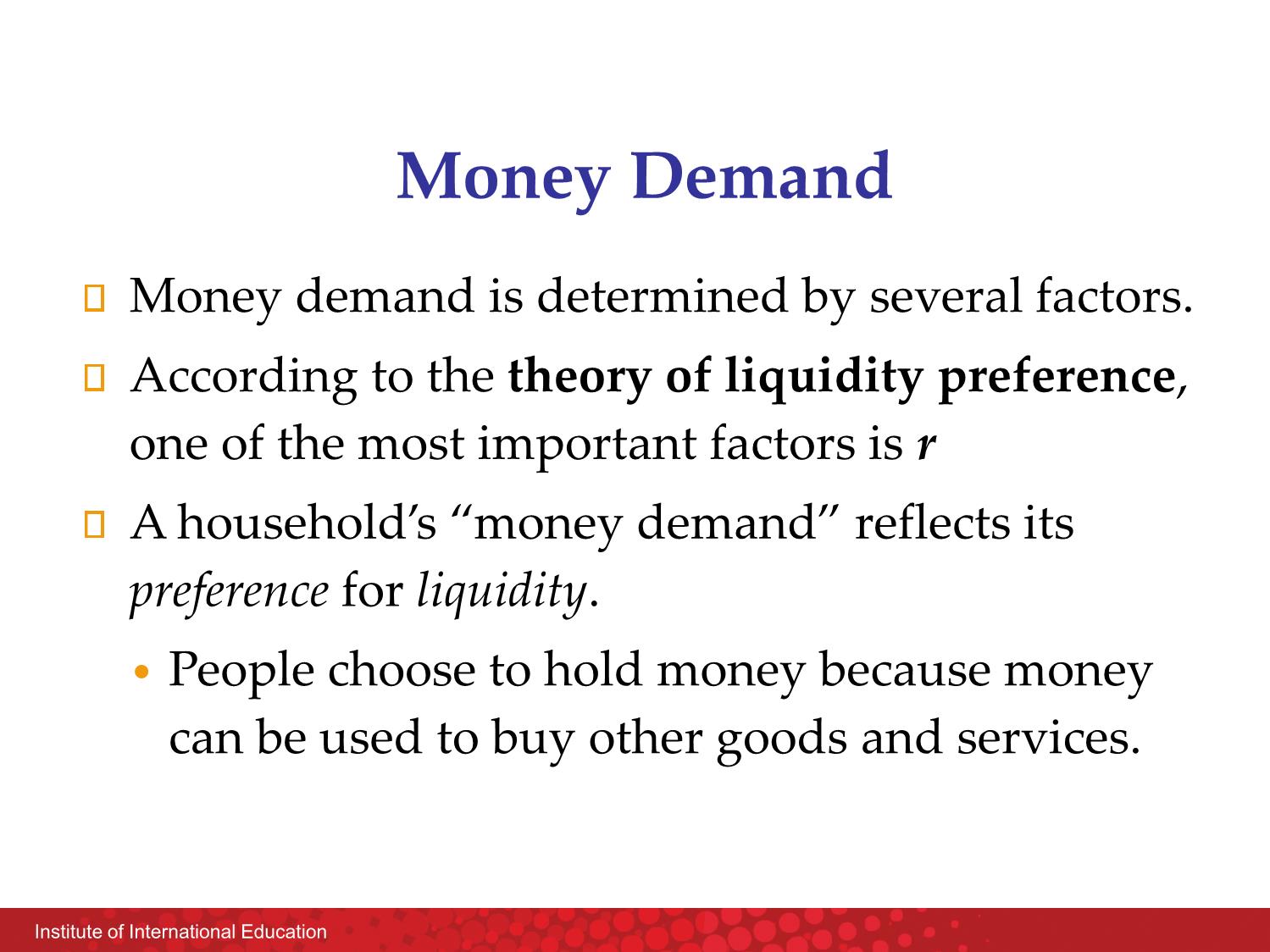
Trang 5
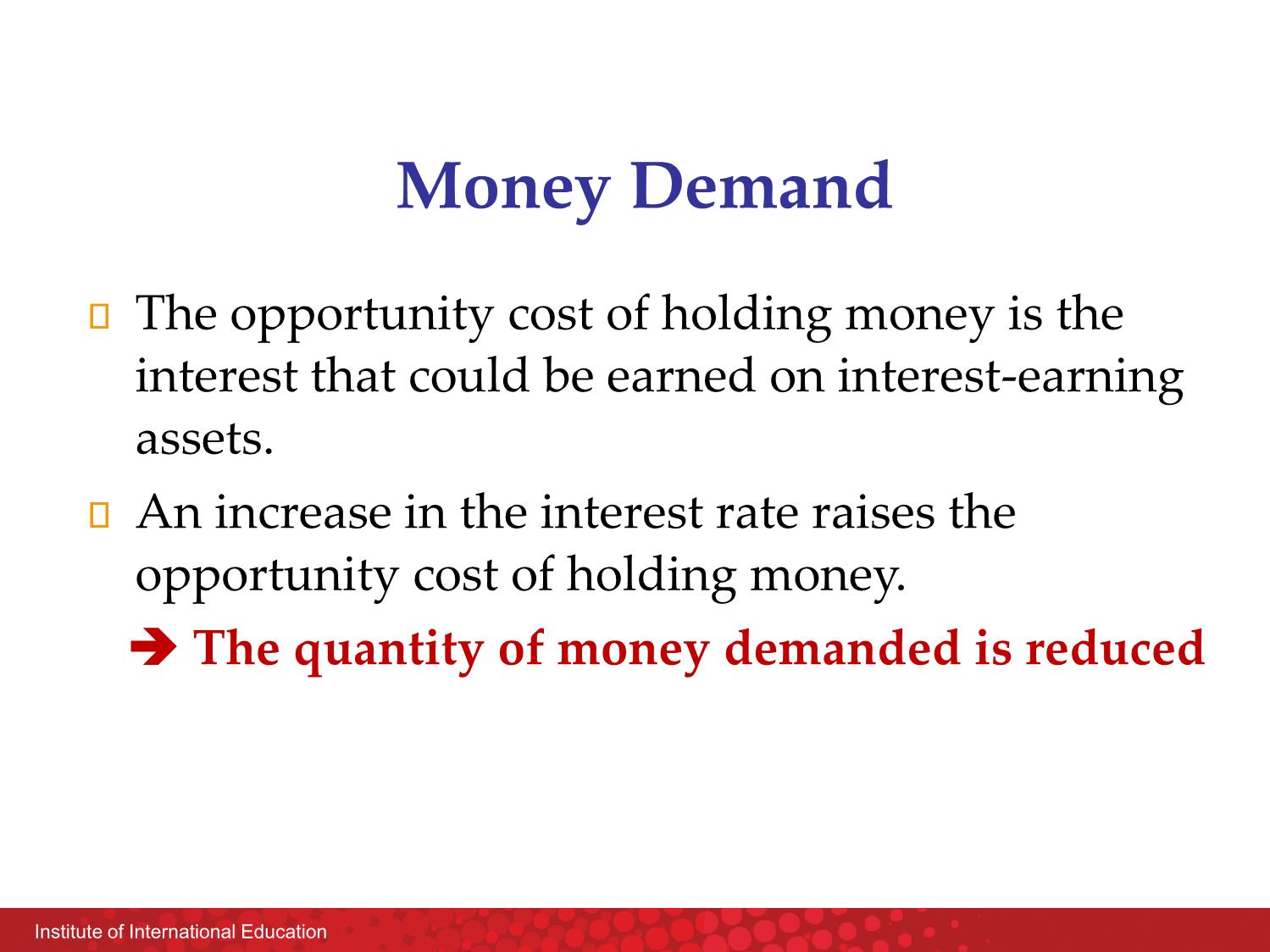
Trang 6
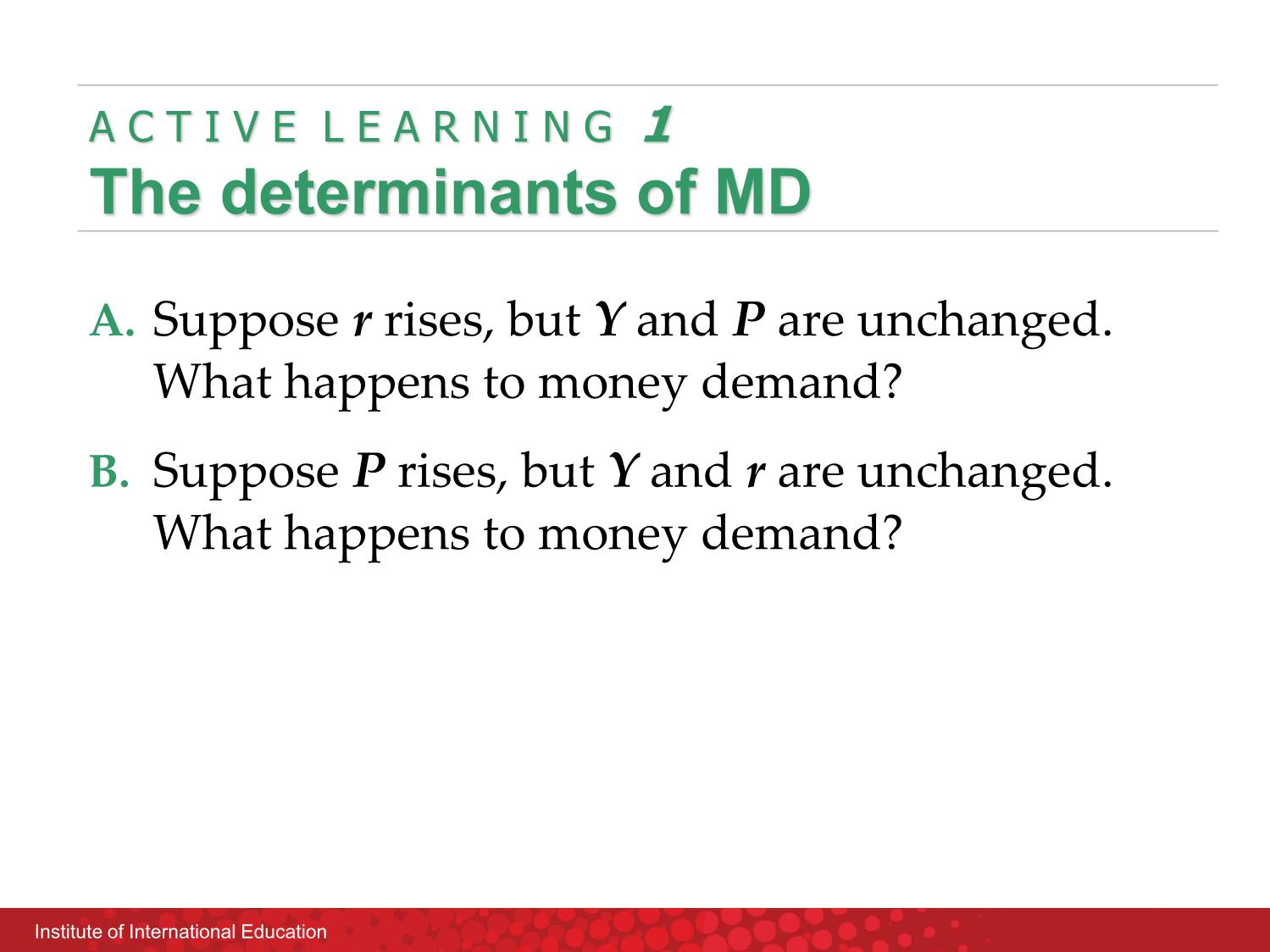
Trang 7
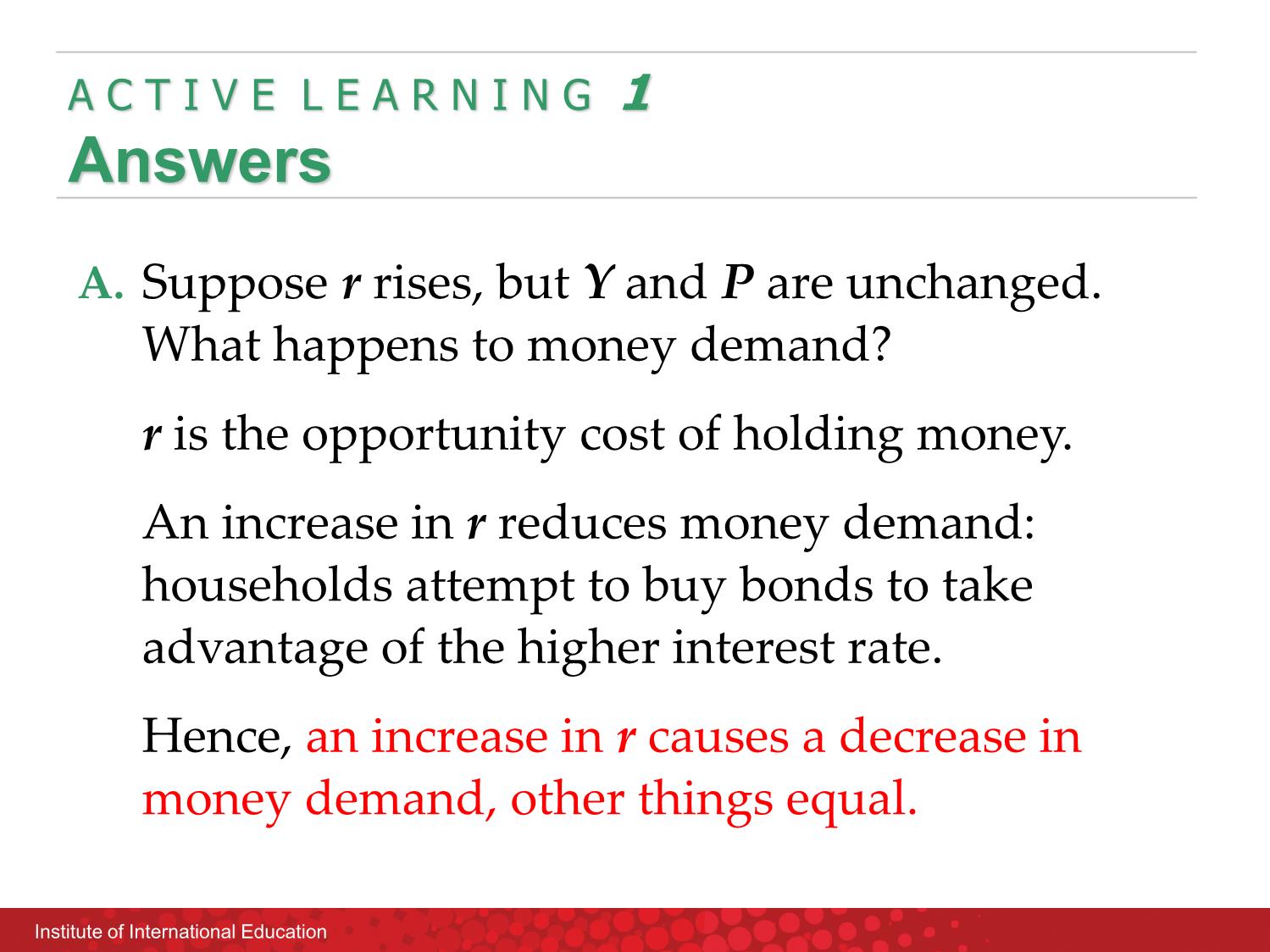
Trang 8
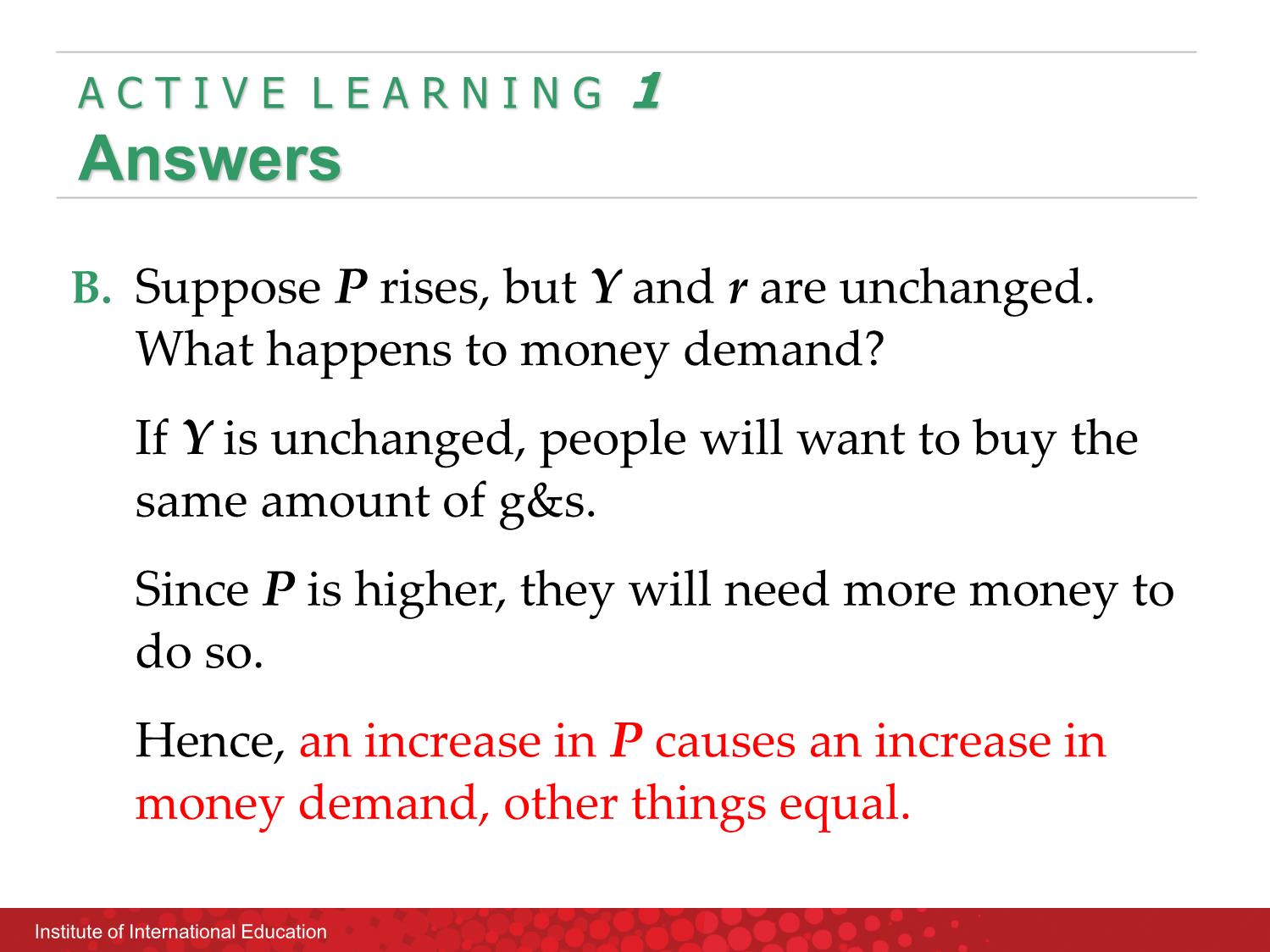
Trang 9
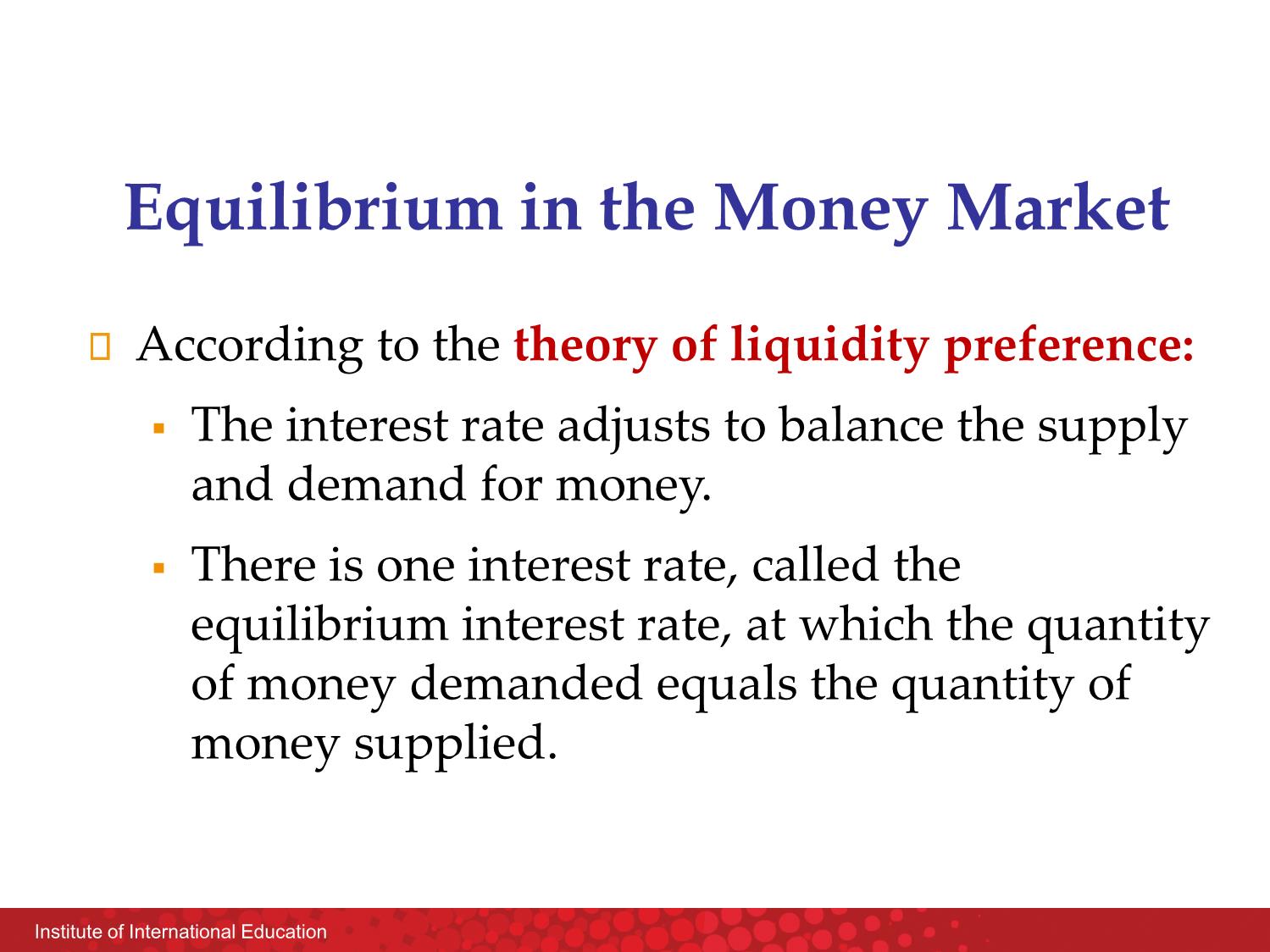
Trang 10
Tải về để xem bản đầy đủ
Bạn đang xem 10 trang mẫu của tài liệu "Bài giảng Macroeconomics - Chapter 4: Short-run economic fluctuation (Part 2) - Nguyễn Thùy Dung", để tải tài liệu gốc về máy hãy click vào nút Download ở trên
Tóm tắt nội dung tài liệu: Bài giảng Macroeconomics - Chapter 4: Short-run economic fluctuation (Part 2) - Nguyễn Thùy Dung
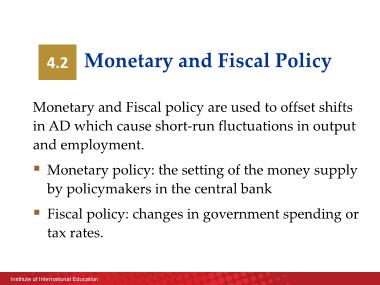
Institute of International Education 4.2 Monetary and Fiscal Policy Monetary and Fiscal policy are used to offset shifts in AD which cause short-run fluctuations in output and employment. ▪ Monetary policy: the setting of the money supply by policymakers in the central bank ▪ Fiscal policy: changes in government spending or tax rates. demand by using monetary and fiscal Institute of International Education How Monetary Policy Influences AD ▪ Recall, the AD curve slopes downward for three reasons: ▪ The wealth effect ▪ The interest-rate effect ▪ The exchange-rate effect ▪ A supply-demand model that helps explain the interest-rate effect and how monetary policy affects AD. Institute of International Education The Theory of Liquidity Preference The theory of liquidity preference is developed in order to explain what factors determine the economy’s interest rate (denoted r) According to the theory, the interest rate adjusts to balance the supply and demand for money. Institute of International Education Money Supply ▪ The money supply is controlled by the Fed through: ❑Open-market operations ❑Changing the reserve requirements ❑Changing the discount rate ▪ Thus, the quantity of money supplied does not depend on the interest rate and is vertical. Institute of International Education Money Demand Money demand is determined by several factors. According to the theory of liquidity preference, one of the most important factors is r A household’s “money demand” reflects its preference for liquidity. • People choose to hold money because money can be used to buy other goods and services. Institute of International Education The opportunity cost of holding money is the interest that could be earned on interest-earning assets. An increase in the interest rate raises the opportunity cost of holding money. ➔ The quantity of money demanded is reduced Money Demand Institute of International Education A. Suppose r rises, but Y and P are unchanged. What happens to money demand? B. Suppose P rises, but Y and r are unchanged. What happens to money demand? A C T I V E L E A R N I N G 1 The determinants of MD Institute of International Education A. Suppose r rises, but Y and P are unchanged. What happens to money demand? r is the opportunity cost of holding money. An increase in r reduces money demand: households attempt to buy bonds to take advantage of the higher interest rate. Hence, an increase in r causes a decrease in money demand, other things equal. A C T I V E L E A R N I N G 1 Answers Institute of International Education A C T I V E L E A R N I N G 1 Answers B. Suppose P rises, but Y and r are unchanged. What happens to money demand? If Y is unchanged, people will want to buy the same amount of g&s. Since P is higher, they will need more money to do so. Hence, an increase in P causes an increase in money demand, other things equal. Institute of International Education Equilibrium in the Money Market According to the theory of liquidity preference: ▪ The interest rate adjusts to balance the supply and demand for money. ▪ There is one interest rate, called the equilibrium interest rate, at which the quantity of money demanded equals the quantity of money supplied. Institute of International Education How r Is Determined MS curve is vertical: Changes in r do not affect MS, which is fixed by the Fed. MD curve is downward sloping: A fall in r increases money demand. M Interest rate MS MD1 r1 Quantity fixed by the Fed Eq’m interest rate Institute of International Education How the Interest-Rate Effect Works AD (b) The Aggregate Demand Curve Quantity of Output 0 Price Level (a) The Money Market Quantity of Money Quantity fixed by the Fed 0 r1 MSInterest Rate MD1 Y1 P1 MD2 2. increases the demand for money 1. An increase in the price level P2 3. which increases the equilibrium equilibrium rate r2 4. which in turn reduces the quantity of goods and services demanded. Y2 Institute of International Education Monetary Policy and AD ▪ The Fed can shift the AD curve when it changes monetary policy. ▪ Changes in monetary policy can be viewed either in terms of a changing target for the interest rate or in terms of a change in the MS ➢Contractionary monetary policy: depressing AD by keeping the MS lower and interest rates higher ➢Expansionary monetary policy: aimed at expanding AD by increasing MS or lowering interest rate Institute of International Education Y2 AD2 3. which increases the quantity of goods and services demanded at a given price level. 1. When the Fed increases the MS MS2 Y1 P Quantity of Output 0 Price Level AD1 (a) The Money Market Quantity of Money 0 MS1 r1 Interest Rate (b) The Aggregate-Demand Curve r2 2. the equilibrium interest rate falls MD A Monetary Injection Institute of International Education For each of the events below, - determine the short-run effects on output - determine how the Fed should adjust the MS and interest rates to stabilize output A. Congress tries to balance the budget by cutting govt spending. B. A stock market boom increases household wealth. C. War breaks out in the Middle East, causing oil prices to soar. A C T I V E L E A R N I N G 2 Monetary policy Institute of International Education A. Congress tries to balance the budget by cutting government spending. This event would reduce AD and output. To offset this event, the Fed should increase MS and reduce r to increase AD. A C T I V E L E A R N I N G 2 Answers Institute of International Education A C T I V E L E A R N I N G 2 Answers B. A stock market boom increases household wealth. This event would increase AD, raising output above its natural rate. To offset this event, the Fed should reduce MS and increase r to reduce AD. Institute of International Education How Fiscal Policy Influences AD ▪ Fiscal policy: refers to the government’s choices regarding the overall level of government spending and taxes. ▪ Expansionary fiscal policy ▪ an increase in G and/or decrease in T ▪ shifts AD right ▪ Contractionary fiscal policy ▪ a decrease in G and/or increase in T ▪ shifts AD left Institute of International Education Changes in Government Purchases When the government alters its own purchases of goods or services, it shifts the AD curve directly. 2 macroeconomic effects that cause the size of the shift in AD to differ from the change in govt purchases ▪ The multiplier effect ▪ The crowding-out effect Institute of International Education Government purchases are said to have a multiplier effect on AD. Each dollar spent by the government can raise the AD for g&s by more than a dollar. 1. The Multiplier Effect Multiplier effect: the additional shifts in AD that result when expansionary fiscal policy increases income and thereby increases consumer spending household as wages, profits, interests lead to another round of rising income Institute of International Education 1. The Multiplier Effect AD1 Quantity of Output Price Level AD2 1. An increase in government purchases of $20 billion initially increases AD by $20 billion $20 billion AD3 2. but the multiplier effect can amplify the shift in AD Institute of International Education How big is the multiplier effect? It depends on how much consumers respond to increases in income The formula for the multiplier is: Spending Multiplier = 1/(1 - MPC) Marginal propensity to consume (MPC): the fraction of extra income that households consume rather than save. 1. The Multiplier Effect Institute of International Education The size of the multiplier depends on MPC. E.g., if MPC = 0.5 multiplier = 2 if MPC = 0.75 multiplier = 4 if MPC = 0.9 multiplier = 10 1 1 – MPC Y = G A Formula for the Multiplier The multiplier A bigger MPCmeans changes in income cause bigger changes in C, which in turn cause more changes in Y. Institute of International Education 2. The Crowding-Out Effect ▪ Fiscal policy may not affect the economy as strongly as predicted by the multiplier. ▪ A fiscal expansion raises r, which reduces investment, and puts downward pressure on AD Crowding-out effect: the offset in AD that results when expansionary fiscal policy raises the interest rate and thereby reduces investment spending Institute of International Education AD3 4. which in turn partly offsets the initial increase in AD AD1 (b) The Shift in AD Quantity of Output0 Price Level (a) The Money Market Quantity of Money Quantity fixed by the Fed 0 r1 MD1 MS Interest Rate 1. When an increase in government purchases increases AD AD2 $20 billion 3. which increases the equilibrium interest rate r2 MD2 2. the increase in spending increases MD 2. The Crowding-Out Effect Institute of International Education ▪ When the government increases its purchases by $20 billion, AD for goods and services could rise by more or less than $20 billion. ▪ Depending on whether the multiplier effect or the crowding-out effect is larger. Changes in Government Purchases out effect pushes the Institute of International Education Changes in Taxes ▪ A tax cut: Households will save some of this additional income, but they will also spend some of it on consumer → shifting AD to the right. ▪ The size of the shift is affected by the multiplier and crowding-out effects. ▪ The change in income resulting from a $1 increase in T: Tax Multiplier = - MPC / (1 - MPC) Institute of International Education Changes in Taxes ▪ It is also determined by the households’ perceptions about the permanency of the tax change. ▪ A permanent tax cut causes a bigger increase in C – and a bigger shift in the AD curve – than a temporary tax cut. ▪ The tax multiplier is smaller than the spending multiplier Institute of International Education A C T I V E L E A R N I N G 3 Exercise The economy is in recession. Shifting the AD curve rightward by $200b would end the recession. A. If MPC = 0.8 and there is no crowding out, how much should government increase G to end the recession? B. If there is crowding out, will government need to increase G more or less than this amount? Institute of International Education A C T I V E L E A R N I N G 3 Answers A. Multiplier = 1/(1 – 0.8) = 5 Increase G by $40b to shift aggregate demand by 5 x $40b = $200b. B. Crowding out reduces the impact of G on AD. To offset this, Government should increase G by a larger amount. Institute of International Education demand and stabilize the economy? The government should avoid being the cause of economic fluctuations. Govt should use policy to reduce these fluctuations: ▪ GDP falls below its natural rate, use expansionary monetary or fiscal policy to prevent or reduce a recession. ▪ GDP rises above its natural rate, use contractionary policy to prevent or reduce an inflationary boom. Active Stabilization Policy Institute of International Education Automatic Stabilizers ▪ Automatic stabilizers: changes in fiscal policy that stimulate AD when economy goes into recession, without policymakers having to take any deliberate action ▪ Automatic stabilizers include the tax system and some forms of government spending. programs automatically rises,
File đính kèm:
 bai_giang_macroeconomics_chapter_4_short_run_economic_fluctu.pdf
bai_giang_macroeconomics_chapter_4_short_run_economic_fluctu.pdf

